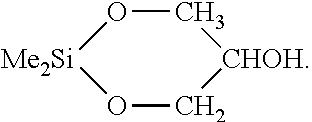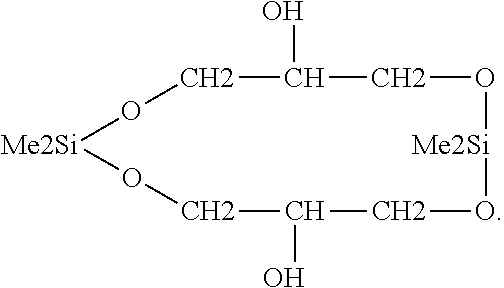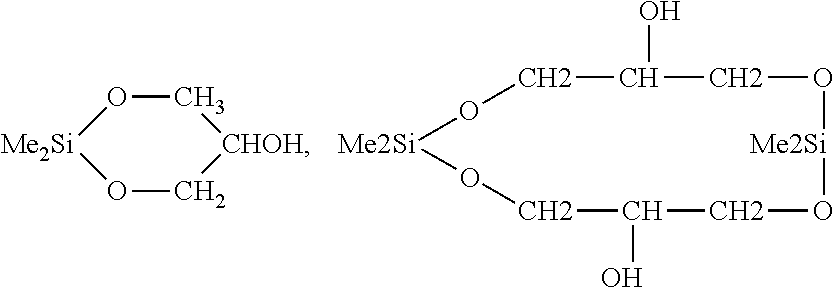Spontaneous Nucleic Acid Purification and Concentration In A Single Step
a technology of nucleic acid and purification, applied in the direction of group 4/14 element organic compounds, chemistry apparatus and processes, organic chemistry, etc., can solve the problems of insignificant concentration of biomarkers in patients at early stage, inability to detect patients, and inability to treat patients or save lives, etc., to achieve easy automation, high throughput, and simple purification and concentration process
- Summary
- Abstract
- Description
- Claims
- Application Information
AI Technical Summary
Benefits of technology
Problems solved by technology
Method used
Image
Examples
example 1
on of PEG-Organosilicon Complex
a) Drying PEG 8000
[0120]PEG 8000 (sigma) was dissolved in benzene (B.P. 79°-80° C.) and the water-organic azeotrope (B.P. 65° C.) was distilled off. PEG 8000 was recovered by removal of solvent under reduced pressure, and was finally dried overnight at room temperature under vacuum.
[0121]Dichloromethane (ANALAR from British Drug House, Poole, U.K) was dried over molecular sieve A3 (100 g per liter of solvent) overnight at room temperature.
c) Activation of PEG with Tresyl Chloride
[0122]Activation of PEG-8000 with tresyl chloride was carried out using a molar ratio of tresyl chloride to available hydroxyl groups in PEG of 2.5:1.
[0123]Dry PEG (18 g. 3.5 mmol) was dissolved in dry dichloromethane (45 mL) at room temperature. The mixture was cooled to 0° C. and stirred magnetically. Then 1.125 mL (14 mmol) pyridine (BDH, U.K.) and 1 mL (9 mmol) of tresyl chloride (Fluka AG, Switzerland) were added dropwise at 0° C. The reaction was ...
example 2
on of PEG-Organosilicon Complex
[0131]Steps (a) to (d) in Example 1 were repeated.
e) Reaction Between Organosilicon and Tresylated PEG, Wherein the Organosilicon has the Formula
[0132]
[0133]The reaction was conducted according to the following steps:[0134](1) Organosilicon was dissolved in aqueous phase;[0135](2) Tresylated PEG (the amount of organosilicon is preferably 3% of the total weight of tresylated PEG in this example) was suspended in a sodium phosphate buffer (pH 7.5); (3) Dispersing the sodium phosphate buffer containing tresylated PEG into the aqueous phase, wherein the mixture was gently stirred at room temperature;[0136](4) Allowing the organosilicon and tresylated PEG react at the interface of the organic phase and the aqueous phase to form a polymer-modifier complex; and[0137](5) Separating the PEG-organosilicon complex from the solution.
example 3
on of Target Nucleic Acids in TE Buffer
[0138]The nucleic acid-containing material was mixed with a TE buffer solution. The TE buffer comprises: 10 mM Tris (pH 8.0), 50 μM EDTA, and 20 μg / mL polyadenylic acid.
PUM
| Property | Measurement | Unit |
|---|---|---|
| particle diameter | aaaaa | aaaaa |
| particle diameter | aaaaa | aaaaa |
| particle size | aaaaa | aaaaa |
Abstract
Description
Claims
Application Information
 Login to View More
Login to View More - R&D
- Intellectual Property
- Life Sciences
- Materials
- Tech Scout
- Unparalleled Data Quality
- Higher Quality Content
- 60% Fewer Hallucinations
Browse by: Latest US Patents, China's latest patents, Technical Efficacy Thesaurus, Application Domain, Technology Topic, Popular Technical Reports.
© 2025 PatSnap. All rights reserved.Legal|Privacy policy|Modern Slavery Act Transparency Statement|Sitemap|About US| Contact US: help@patsnap.com



